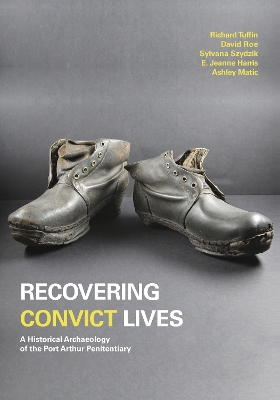Studies in Australasian Historical Archaeology
1 total work
Recovering Convict Lives
by Richard Tuffin, David Roe, Sylvana Szydzik, E. Jeanne Harris, and Ashley Matic
The World Heritage-listed Port Arthur penitentiary is one of Australia’s most visited historical sites, attracting over 400,000 visitors each year. Designed to incarcerate 480 men, between 1856 and 1877 thousands of convicts passed through it.
In 2013, archaeologists began one of the largest ever excavations of an Australian convict site. Recovering Convict Lives: A Historical Archaeology of the Port Arthur Penitentiary makes their findings available to general readers for the first time. Extensively illustrated, it is a fascinating journey into the inner workings of the penal system and the day-to-day lives of Port Arthur convicts.
Through the things they left behind – the sandstone base of a prison wall, a clay pipe discarded in a washroom, gambling tokens dropped between floorboards – this book tells their stories.
Praise for Recovering Convict Lives
'In this richly illustrated volume readers will be taken on an archaeological tour of a lost world of work, leisure and punishment. A forensic reconstruction of one of Australia’s most iconic buildings, Recovering Convict Lives peels away the layers of time to reveal the hidden history of everyday life in a penal station.'
- Professor Hamish Maxwell-Stewart, author of Closing Hell’s Gates
'Recovering Convict Lives is the kind of substantial and significant publication that does justice to one of Australia’s most iconic heritage sites. The authors skillfully combine complex evidence from diverse sources in order to produce a nuanced and detailed account of the experiences of those who lived at the penitentiary. The discussion ranges seamlessly between fine-grained glimpses of individual lives and the global systems and processes that structured local action. Flowing, readable text and abundant illustrations are partnered with ready access to technical archaeological reports provided in an online repository, an elegant solution that allows readers to choose the amount of detail they want. The authors powerfully demonstrate the value of an integrated, multidisciplinary approach and showcase the strengths of historical archaeology as a discipline at the intersection of documentary and non-documentary evidence. Recovering Convict Lives presents some of the "unwritten histories" of Port Arthur - stories of places, spaces and lives that have been not previously seen. This impressive book provides a compelling argument for the need to tell and understand convict stories in order to understand the genesis of modern systems of incarceration.'
- Professor Susan Lawrence, author of Sludge: Disaster on Victoria’s Goldfields
